This article from the Wall Street Journal details the import resrictions on the largest solar panel suppliers. These restrictions, combined with tariffs dating back to the Trump administration, and the general difficulties with supplies, shipping, and labor have caused disruption in the construction pipeline for many of the largest projects in the US, and have caused headaches and layoffs among some installers. This is typical of what we sometimes see of the US federal policy, with different parts of the government working against themselves. In the recent IRA, new incentives and goals were put into place to accelerate the transition to clean energy, while these import restrictions are dampening the industry. The manufacturers claim the accusations of labor abuses are unfounded, and for some reason, it is taking years before there is a determination by the US govt.
https://www.wsj.com/articles/solar-panel-shortage-snarls-u-s-green-energy-plans-11669671279
Here at Power Trip Energy, we have been blessed with good predictable supplies of modules from Sunpower. We have been Sunpower dealers since 2010, and have been so happy with their quality and reliability. These last couple of years, we have been subject to supply shortages with various electrical supplies at times, but we have maintained a good supply of Sunpower pv modules. We have significantly increased our inventory of all parts on hand since early 2020 to avoid surprises. Sunpower products are not subject to these import restrictions, and in the past, they have won accolades for labor policy and clean materials handling practices in their manufacturing process.
Sometimes the solar industry is a bumpy ride, and insiders sometimes call it the solar coaster. If you work with us, we make it our goal that your only excitement will be from the production of reliable clean power. Please call us today if you would like to lean more.
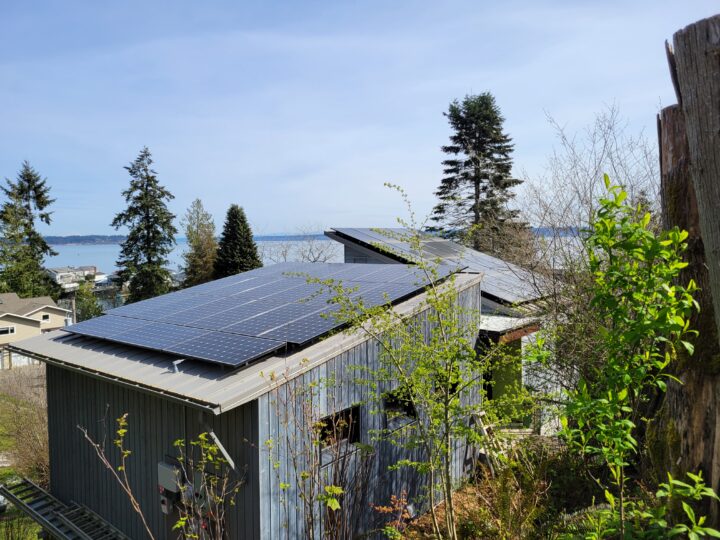
8.6 KW Phase II Sunpower Array in background, Sept 2022, with the 5.4 KW Phase I Sunpower Array in foreground, Oct 2014
by Andy Cochrane | Nov 30, 2022
The Forum will be anchored by several panelists at an in-person event at the Cotton Building in Port Townsend on Saturday, October 15th from 10-4pm. Morning Speakers will cover the processes from Purchasing Land, though Feasibility & into Permitting. Afternoon Speakers will drill down on current Building Incentives, ending with a panel on Future Uses for your Home.
Power Trip Energy’s Andy Cochrane will be on hand ini the afternoon to help make clear the available incentives for grid-tied solar pv.
The Cotton Building is located at 607 Water Street in Port Townsend.
Each section will include a Q&A format.
http://jeffcohomebuilders.com/housing-forum-2022/
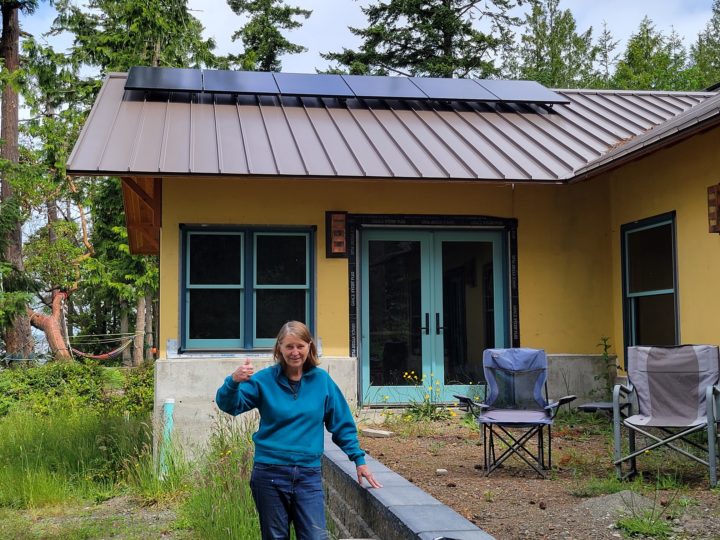
5.25 KW Sunpower Array, Nordland, September 2021
by Andy Cochrane | Oct 10, 2022
2030 Coming Up Quick – Let’s Goooo!
https://content.govdelivery.com/accounts/WADOC/bulletins/325cec1
Here in WA, the UTC (Utilities and Transportation Commision) and Dept of Commerce are the main regulators helping our privately owned and public utilities stay on track to meet our stated goals of carbon neutral by 2030 and 100% renewable energy by 2045. These rules and clarifications are important steps in meeting our goals.
We are helping our clients do their part. Would you like to join us?
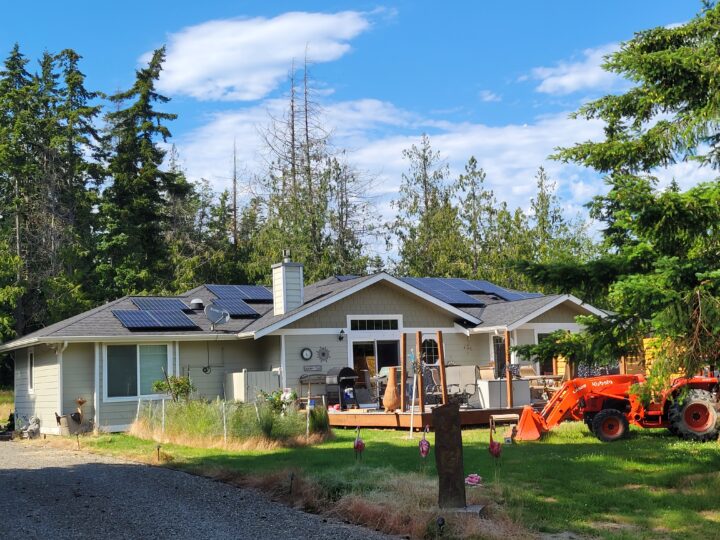
16.5 kw Sunpower on Clallam PUD grid in Sequim, June, 2022
by Andy Cochrane | Aug 1, 2022
Sunrun announced they have been in business 15 years, becoming the nation’s largest solar installer with installations in 22 states.
https://www.globenewswire.com/news-release/2022/06/28/2470320/0/en/Sunrun-Celebrates-15-Years-Leading-the-Nation-s-Clean-Energy-Transition.html
Some of the other statistics Sunrun shared in their press release:
- 11,000 employees
- 700,000 customers served
- 5000 MW installed
During the 20 years we have been installing solar here at Power Trip Energy, we have repeatedly made the decision not to grow beyond our small family business size. The first couple of those 20 years were pretty lean, as we invested our time in educating the market and laid the groundwork for companies that followed our lead, like Sunrun.
As I review these same statistics for our company, I am reassured that we have made the right choice in staying lean and mean, operating without the inevitable waste inherent to large corporations. I think these statistics show that our company is significantly more efficient than Sunrun’s in terms of projects installed and MW of pv installed per employee.
- 10 employees (1/1100 the employees as Sunrun)
- 1000 customers served (1/700th the number of clients as Sunrun)
- 6.5 MW solar installed (1/1000 the installed capacity as Sunrun)
Ludicrous comparisons and all kidding aside, congrats to Sunrun, a company that appears to be well-intentioned and effective. We still prefer to do things our way, and hope you will join our little solar family.
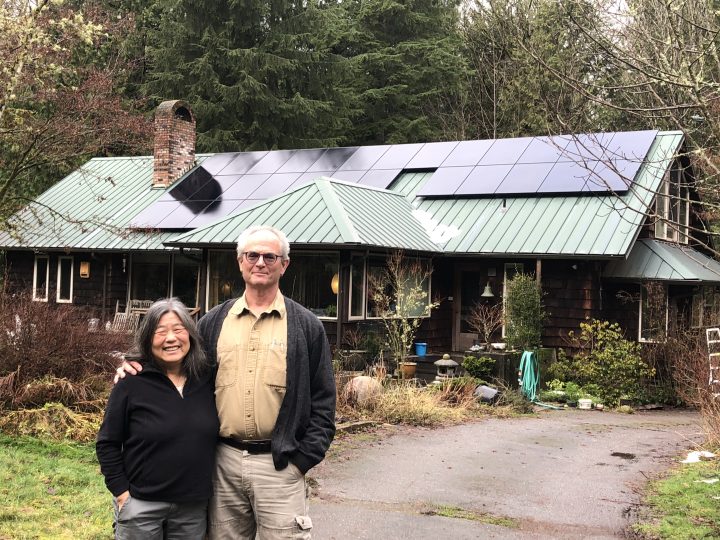
10.5 KW Sunpower Array, Bainbridge Island, WA 2019
by Andy Cochrane | Jun 30, 2022
We have been installing roof-top solar PV for our friends and neighbors on the Olympic and Kitsap Peninsulas for over 20 years. Our reputation is vital and taking care of our clients is a huge part of what makes our business fun. Solar has (finally) become popular in the mainstream, and sadly our state has attracted some scam artists. Please do you due diligence and work with someone that has your long term best interests at heart. We are working hard to install clean energy and create the world we want to live in. A recent KUOW news story exposed a few issues with some disreputable installers and is worth a 4 minute listen.
https://kuow.org/stories/surge-in-homes-powered-by-the-sun-but-do-your-homework-so-you-don-t-get-burned
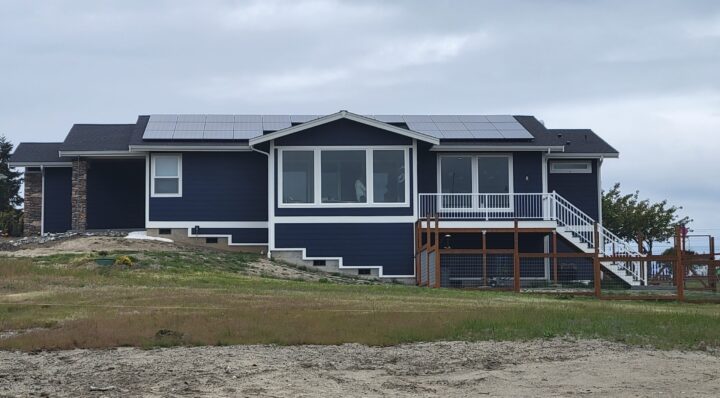
12 KW Sunpower array, Diamond Point, WA, May 2022
by Andy Cochrane | Jun 23, 2022
Here at Power Trip Energy, we have been promoting and Installing roof-mounted solar PV arrays for 20 years. It makes a lot of sense to us, it has only gotten more attractive over time, and we pride ourselves on helping our clients and making a positive contribution to our community. Lately there have been a profusion of new companies entering the market, and their claims make us wonder if they have the same motivations we do. Our friends at Western Solar in Bellingham have been in the business as long as we have and they have built a reputation of honesty, reliability, and competence. They wrote a nice blog article and we are sharing. It is a good summary of things to look out for, written in a clear way, less emotional and more level-headed than I could have written it. “Protect yourself from Solar Scams and High Pressure Sales.”
www.westernsolarinc.com//solar-red-flags/
If you are in Whatcom County, call Western Solar. If you are in Jefferson, Clallam, or Kitsap Counties, that is what we consider home and we would love to give you straight truth, and a great solar project at a fair price.
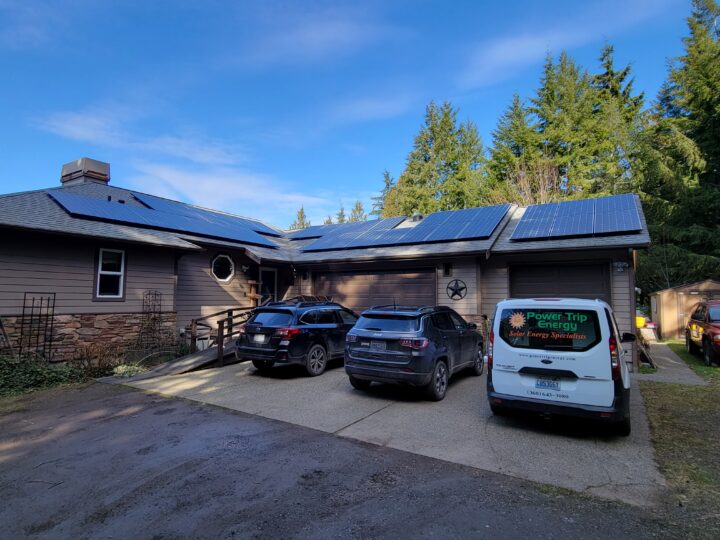
15 KW Sunpower, Seabeck, PSE Grid, Feb 2022
by Andy Cochrane | Jun 1, 2022
LG has been a leading brand of solar modules in the US, and less so, world-wide for over a decade now. I noticed them enter the market in 2010, along with so many new entrants that year at the Solar Power International in Los Angeles. When I saw that LG, Samsung, and Hyundai among others were making a big splash at that trade show, it was a clue that the market would be dramatically changing and growing. Through the first half of that decade we not only saw continued geometric growth of the industry, but jaw-dropping price decreases. Those price decreases helped fuel industry growth, but also herlded the failure of many good American companies that could not cut costs and survive (RIP Evergreen, UniSolar, Stirling Energy, NanoSolar, Solyndra, Day4, SpectraWatt, etc.) At that time, we had just begun our relationship with Sunpower, based in San Jose, CA, which had been in the solar industry since 1985, and has been consistently recognized as the highest efficiancy and quality.
I was surprised to see LG walk away from the solar sector since they have such a good reputation, a good product, significant market share, and some of the greatest electronics manufacturing expertise on the planet. If they can’t make good profit with all those advantages going for them, what does that say about the industry as a whole? The low cost of multiple giant Asian solar manufacturers, the difficulties produced by Chinese dumping (substantiated by the FTC, and a basis for tariffs), and the consumer expectation that solar will continue to decrease in price, have combined to create difficult market conditions for manufacturers.
The official announcement from LG cites supply chain issues, and increasing materials and logistics costs. https://www.solarpowerworldonline.com/2022/03/lgs-advice-to-u-s-installers-as-it-exits-solar-panel-manufacturing/
As recently as last year, LG was forecasting growth and continuing to commit to the sector. https://www.lg.com/global/business/solar-blog/solar-market-trend
Sunpower has been able to weather the difficulties present in this market through growth, cost-cutting, price decreases, outside investment, and various restructuring over the years. Sunpower is not the least expensive product on the market, far from it. We feel that going with the highest quality company, with a track record of reliability and consistency, is the best way to make this solar investment for your home.
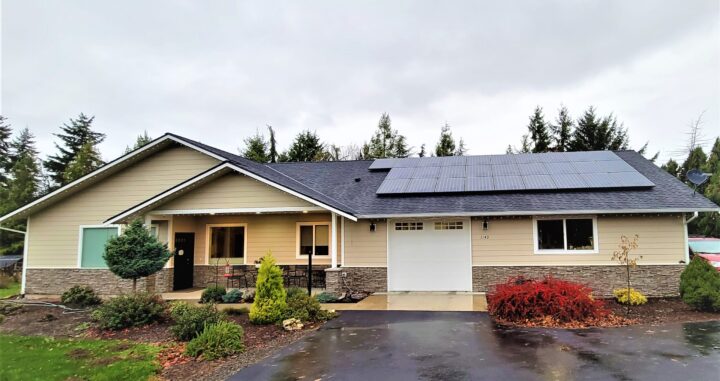
10 KW Sunpower Array, Sequim, WA, October 2021
by Andy Cochrane | Mar 14, 2022
The Pacific Northwest National Lab in Richland is running a Smart Grid simulation and implementiing it on their campus and also in Spokane’s Eco District in conjunction with Avista, the electrical utility there.
In general, the ability to coordinate between the consumer’s needs and ability to provide power with distributed generation and storage, and the utilities needs and costs on the variable wholesale power market, will make the grid more efficient, cleaner, and less expensive for everyone. The study is linked below, and we view this progress as key to allowing individuals to maximize their economic returns from installing solar while having the greatest possible reduction of carbon emissions and other pollution.
PNNL Researchers are estimating consumer savings nationally as $50 Billion per year, and reducing energy output equivalent to 180 coal fired power plants. What a gross disgusting waste and what a tremendous opportunity for improvement – let’s do it!
We are hopeful for progress along these lines, especially in conjunction with Electric Vehicles. In the meanwhile, the best thing you can do is to install a grid-tied pv system on your home or business today. That will save you money now, and give your home the foundation to take best advantage of whatever energy policies are coming our way.
https://www.pnnl.gov/news-media/how-smart-electric-grid-will-power-our-future
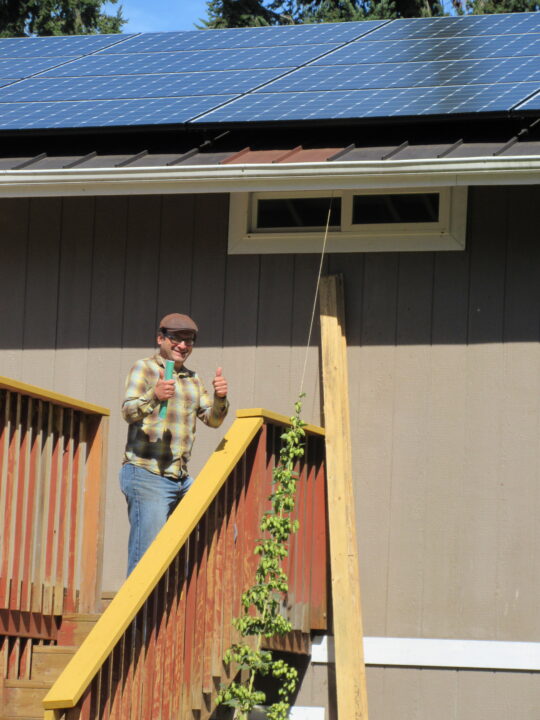
9.8 KW Sunpower PV Array, Port Hadlock, WA, Jefferson PUD Grid, Sept 2021
by Andy Cochrane | Feb 1, 2022
Oil spills are heart-wrenching anywhere, here at home on our own Pacific coast hits me the hardest. I feel these accidents are the result of our collective laziness and a few people’s greed. We can do so much better.

Workers in protective suits clean the contaminated beach after an oil spill in Newport Beach, California, on Wednesday, October 6, 2021.
This sad situation brings several larger issues to mind for me; things I don’t understand well, but I feel they are all related.
– Our country is going further into debt each year, (blowing through the 100% debt to GDP ratio during the Trump administration, and reaching about 125% for 2020.)
– We are essentially borrowing money from China at this point, to subsidize the oil industry and our gasoline-based import consumer culture.
– Our oil based consumer import economy is decreasing American manufacturing jobs, and harming our ability to provide for ourselves.
– The drilling, refining and burning of oil and gas is causing horrendous damage to oceans, wetlands and wildlife here at home, and globally altering the atmospheric chemistry in a dangerous manner.
– There is a finite amount of oil, which is a base ingredient for mountains of plastic junk in addition to incredibly useful items like contact lenses and bike helmets that plastic is great for, where a small amount of plastic makes products that make our lives much better. However we take that oil and we waste nearly all of it by burning it.
I know these issues can not be remedied by installing solar panels on roofs here on the Olympic Peninsula, but I am stumped as for a better thing for me to be doing at the moment.
Please do what you can to help address these complex issues, which may include riding a bike or driving an EV, buying less unnecessary stuff, or maybe even installing a solar array on your roof.

5.25 KW Sunpower Array, Nordland, September 2021
by Andy Cochrane | Oct 8, 2021
Here on the Olympic Peninsula, we don’t face the same issues as they do in the Gulf States, but we are not beyond the reach of severe weather, so would do well to learn from the mistakes of others. This article at Canary Media discusses energy issues in New Orleans after Hurricane Ida, where at least 300,000 people remained without power two weeks after the storm.
After Hurricane Katrina in 2005, the utility was required to rebuild power lines to withstand 120 mph winds, and they were allowed to rate-base those costs, thereby charging extra to the consumers. Ida’s winds reached 100 mph and there were numerous significant failures of those lines.
Entergy, which is the utility, overcame significant opposition to building a new polluting natural gas power plant in New Orleans. One of the promises Entergy made was that this plant would be able to operate a micro-grid to keep the power on power on the core of the city even if there were widespread outages. It failed during Ida.
The gas plant is especially galling to local clean energy activists since it is the direct actions of the oil and gas industry that contribute to New Orleans’ vulnerability through destruction of the buffering wetlands, and globally through carbon emissions’ contribution to climate change.
Resilience is attainable through replacement of those gas plants and above ground power lines, with solar, wind, and storage in a distributed manner, along with underground power lines.
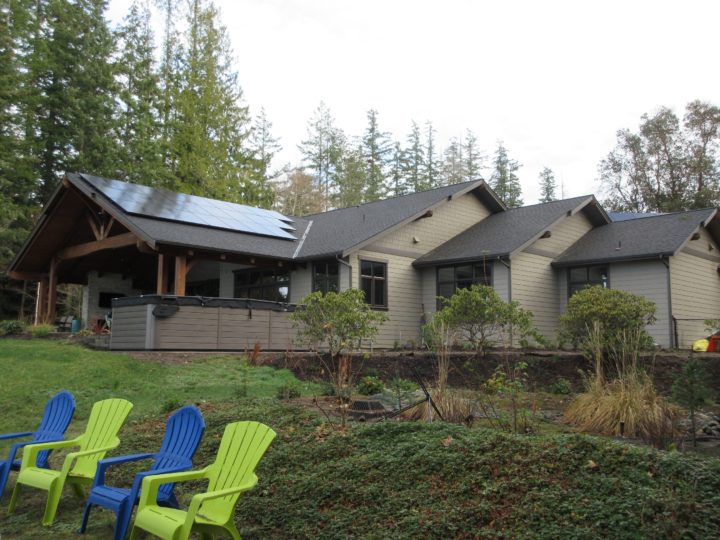
11 KW Sunpower Array, Bremerton WA, January, 2021
by Andy Cochrane | Sep 17, 2021









